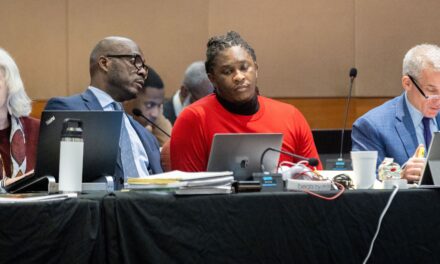Art
Samuel Anderson
Jun 29, 2023 9:27PM
Representing a three-dimensional landscape on a two-dimensional surface like canvas is always a give-and-take between the real and imaginary. But landscape painters who step into fantastical terrain have all the more choices to make when it comes to achieving that balance. A more experimental approach to their subject matter allows painters to showcase their formal abilities, as well as an unexpected, surprising worldview.
By stretching reality’s colors and forms, these artists allow us to navigate imagined spaces that both beckon and resist human contact, while also suggesting a radical reengagement with our own environment. Such work acquires special resonance today, as the landscape itself becomes increasingly mercurial—whether by smoke pollution from wildfires unleashing alien, orange skies in the U.S., or carbon emissions driving a feedback loop of extreme weather worldwide. In the case of these contemporary painters, however, the drastic changes to the environment are confined to the canvas.
B. 1989, Örebro, Sweden. Lives and works in Los Angeles.
Advertisement
L.A.-based artist Camilla Engström’s curvaceous, cartoon-colored landscapes appear to live and breathe. Her warm-hued scenes feel intense yet hospitable, at times occupied by anthropomorphized mountains, or presided over by the goddess-like figure Husa, whom Engström conceived of while developing her fantastical style.
Engström studied fashion at New York’s Fashion Institute of Technology, where technical drawing evolved into more free-flowing imagemaking that renegotiates the lines between real and imagined. “I think [they] started to blur when I began drawing for myself, and drawing more images of Husa,” said Engström. “From there I allowed myself to be much more explorative and meld her with landscapes in my mind.”
An inversion of the name’s meaning (“housemaid” in Swedish), Husa signifies spatial and spiritual transcendence—the kind that Engström, who grew up between Sweden and China, longed for as a child. “I think the long stints in China shaped me,” she said. “There was always a feeling of not belonging, no matter where I was, and that made me curious to explore places that maybe I would feel at home in,” she said.
Now based on L.A.’s east side, Engström is cultivating her “forever home.” “Frogtown Cottage is my soon-to-be first home and home studio,” she told Artsy. “It’s named after the neighborhood, a stretch of land running parallel to the L.A. River—there has been a big effort to bring the river into a more natural state, and it is so exciting to see all the birds that are happily living there.”
B. 1989, London. Lives and works in London.
Daisy Dodd-Noble, Banana, 2023. © Deniz Güzel. Courtesy of the artist.
Daisy Dodd-Noble made the leap from political art to landscapes while studying at the New York Academy of Art under Inka Essenhigh, the figurative painter known for her imaginative scenes. Overwhelmed at the time by the freneticism of Manhattan, Dodd-Noble found that sketching the city’s trees had a stabilizing effect on her. Eventually she began transposing them onto made-up environments, building saturated skies and population-zero expanses around idealized versions of actual trees she had encountered.
Now based in London, she has since trained her vision on trees from her native U.K., Costa Rica, and the south of France, where she recently completed a residency with Bloom Galerie. As much as Dodd-Noble’s vibrant reproductions conjure a pre-Anthropocene innocence, she sees them just as much as expressions of self-knowledge. “I am definitely not attempting to build a new ‘world,’” she said. “I am endeavoring to deepen my own perception of the world around me…then to visually communicate my understanding of the nature of reality and the relationship between us and the world around us.”
B. 1991, Elmira, New York. Lives and works in Brooklyn, New York.
Pine trees predominate the landscapes of Madeleine Bialke, a native of Elmira, New York, now based in Brooklyn. But just as present is the feeling of unease in the trees’ surroundings. Whether it’s an off-color sky or an all-too-placid lake, there’s always something in Bialke’s otherwise idealized scenes that seems to augur an unseen but life-altering force, casting the trees as stand-ins for humanity, and the viewer.
Bialke became fascinated by nature and the secrets it might hold on trips to her family’s Adirondack cabin; it was there that she picked up a copy of Theodore Dreiser’s novel An American Tragedy, which turned out to be based on a crime that occurred on the next lake over—the drowning of Grace Brown by Chester Gillette. “The cultural or historical context of a place is important to me when making paintings.…You look at a place through different-colored glasses when you know [about] its past,” she said.
B. 1981, Bloomington, Indiana. Lives and works in Queens, New York.
Amy Lincoln
Moon & Stars with Blue & Green Rays, 2021
Sperone Westwater
Amy Lincoln’s awe-inducing attention to color and gradient has made her a contemporary leader in both art and design. Each of her prismatic paintings unfolds from a similar, seemingly simple starting point: three colors, plus white. The end goal, however, is encyclopedic: “Limit[ing] myself to three colors…allows me to create a color system within the painting by making sure to show every possible combination of the colors,” Lincoln said.
As Lincoln’s subject matter has moved from the specific to the general, with her more recent seascapes seeming to blur the lines between solid mass and celestial light to infinitesimal degrees, the artist’s star has risen. For instance, her second show at Sperone Westwater this spring coincided with a line of cashmere blankets for the Italian fashion brand Etro. Her inspirational purview, however, remains much the same. “I can mine that little bit of observation for months or years afterwards,” she said. “I’m still repainting plants from paintings I made 10 years ago.”
B. 1973, Slidell, Louisiana. Lives and works in Florence, Massachusetts.
Living and working in central Massachusetts, John McAllister spends 20 hours a week riding his bike in the great outdoors. Nevertheless, this close proximity to nature doesn’t directly shape the elysian scenes he creates. “I spend a lot of time [outdoors] but never think about how it will become a painting because I know that it will be filed away in the subconscious for spontaneous use,” he said. “Imagined elements weigh much heavier in the conscious part of my mind.”
Those intangible elements—varying intensities of oranges, reds, and purples—are what define McAllister’s unmistakable palette and style, while he sees subject matter as secondary. “Foliage, land, and water are there as a structure for light and color to perform upon,” he said. As in the playful linguistic meter he frequently uses in titling works (like serenest surrounds abounds, 2022) and shows (“riot rose summery,” 2016; or “some rhapsodies radiant,” 2021), the compositions are a framework in which to achieve maximum jubilation.
B. 1978, Seoul. Lives and works in Baltimore.
As an environmental scientist, Se Jong Cho studies both Earth’s underlying processes and mankind’s role in disturbing them. She first turned to painting as a discipline about 10 years ago, while analyzing water pollution in the Mississippi River for her PhD. Painting wasn’t a way to gain distance from peoples’ impact on places, but rather to elaborate on its complexity. “I felt that to tell the stories about humans’ extractive use of Earth’s natural resources and consequent environmental degradation, scientific language alone does not suffice,” she explained.
Cho’s landscapes are visually escapist, depicting a protean universe of self-styled, cosmic forms, which nonetheless draw on artistic and scientific precedents. For example, in a series about resource extraction, Cho created a flattened topography modeled after the same aerial and satellite imagery she uses when examining Earth’s surface for scientific research. Joining a more radical feminist tradition for a series called “Blood Clock,” Cho visualized her own menstrual blood floating over a game board, set against a pastiche of Georgia O’Keeffe’s “Lake George” series.
B. 1984, Seattle. Lives and works in Queens, New York.
With her stylized still lifes, Amanda Baldwin has built a devoted fanbase. But, in contrast to her earlier still-life paintings, her geometric landscapes eschew horizon lines and other realistic signifiers in favor of multidimensional depth. Through visual layering and an adroit use of color and shadow, Baldwin invites a pleasurable dislocation, suspending the viewer between mundane and abstract.
Ironically, these quasi-naturalistic forms find a concrete reference point in the artist’s childhood interest in math: “I was really interested in mathematical equations, especially algebra, and found it fascinating how math can be found everywhere in nature, from the curve of a seashell and spiderweb, to mineral formations and sand dunes,” said Baldwin. “The patterning found in my work is a reference to that mathematical curiosity.” Unlike in math, perhaps, the product of Baldwin’s careful distribution of color and texture always feels greater than the sum of its parts.
B. 1979, Worcester, Massachusetts. Lives and works in Brooklyn, New York.
Anna Ortiz, Cascabel, 2022. Courtesy of the artist.
Anna Ortiz finds fantasy and pathos in her contemplative desert scenes, which often serve as imaginary portraits of Mesoamerican figures and archetypes. Born to a Mexican immigrant father in Worcester, Massachusetts, Ortiz draws on Aztec and Mayan mythology in order to lend age-old symbols a personal and down-to-earth resonance.
In Cascabel (2022), for example, the main statue figure sits in a numinous clearing bearing a patchwork of allusions; its tail derives from the serpentine god Quetzalcoatl, while his skull-shaped headdress is that of god of death, Mictlantecuhtli. Despite its heraldic accoutrement, though, the four-eyed figure is weakened and fallible. “I feel it’s important that the statues I’m building appear weathered and irregular, that they embody a history as well as a certain vulnerability,” Ortiz said.
Likewise, Ortiz’s plants and cacti have a last-man-standing quality. Isolated yet animated against the desert scrub, her botanical subjects evoke both longing and endurance. “I like to think of the plants as stand-ins for figures—creatures that can feel alone even when together in the desert,” Ortiz said. “That vulnerability lends itself to considering issues of resilience and compassion.”
B. 1994, Baltimore. Lives and works in Queens, New York.
Given the subject matter of Erica Mao’s paintings—enigmatic scenes of a pre- or post-civilized world—it’s fitting that her practice would also include an ancient art like ceramics. In both mediums, Mao harks back (or projects forward) to a power struggle between humans and their environment that is always unfolding. In her bright paintings, humanoid figures—which Mao calls her protagonists—often appear like outcasts, en route, crossing over untamed land and sea toward an unknown destination.
Though she takes liberties with their surroundings, depicting the terrain rising up and lashing out, she also intends the viewer to find traces of themselves within her works. “Sometimes it feels like I am creating a set for a play or movie, framing the right shot to follow the narrative storyline between the characters,” she said. Despite that vivid worldbuilding, there isn’t necessarily a moral at the end of the story. “My practice is like wandering in a cave with a flashlight,” she said. “As I point the beam of light to different spots I gain another piece to the puzzle.”
B. 1990, New York. Lives and works in Dobbs Ferry, New York.
As imaginative and unrestrained as they appear, Dylan Vandenhoeck’s febrile landscapes are methodical distillations of everyday sensory processes, like sight and working memory. Working primarily en plein air, Vandenhoeck incorporates a broad network of data, including information that our brains normally unconsciously filter out, in order to impart a sense of full-bodied experience.
These data range from peripheral vision of the nose or eyelashes catching light, to entoptic phenomena, sometimes called “floaters,” in which tiny structures in the eye itself become discernible. “Laying down this kind of embodied perspective in paint does often surprise me in the fantastical forms it can take,” said Vandenhoeck. “The result is all the more satisfying to me because it is tethered to life, hinging on an external logic bigger than myself.”
In addition to spending hours on site, he deepens his observations through visual and non-visual documentation, taking notes or recording voice memos to preserve the “senses, thoughts, or conversations” he finds in a given environment. In externalizing and unifying these perceptual structures—what he calls “the things perceptible within perception itself”—Vandenhoeck’s works lend a psychic intensity to everyday reality.
Browse available fantastical landscape paintings in the collection “Fantastical Landscapes.”
Samuel Anderson





